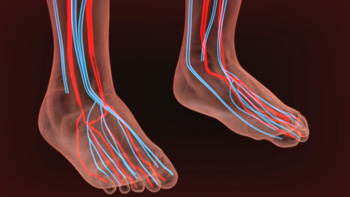The Risks of Peripheral Artery Disease
Monday, 10 August 2020 00:00 Peripheral artery disease (PAD) is a medical condition in which the blood vessels in your lower limbs narrow or become clogged due to the buildup of arterial plaque. This reduction in blood flow means that you have poor circulation, which increases your risk of developing a whole host of potentially serious medical complications, including strokes, heart attacks, and aneurysms. Left undiagnosed and untreated, PAD in your lower limbs can advance to the point where there is limited to no blood flow, resulting in the death of the muscles in your lower limbs and increasing your risk of needing a limb amputation. Fortunately, PAD is easy to screen for and can usually be managed with lifestyle changes and medication, especially if it is detected in its earliest stages. Symptoms of PAD in the lower limbs include pain or cramping while walking, swelling, numbness, skin discoloration, and poorly healing sores. If you experience any of these symptoms, it is strongly recommended that you consult with a podiatrist who can screen for PAD and provide you with treatment options.
Peripheral artery disease (PAD) is a medical condition in which the blood vessels in your lower limbs narrow or become clogged due to the buildup of arterial plaque. This reduction in blood flow means that you have poor circulation, which increases your risk of developing a whole host of potentially serious medical complications, including strokes, heart attacks, and aneurysms. Left undiagnosed and untreated, PAD in your lower limbs can advance to the point where there is limited to no blood flow, resulting in the death of the muscles in your lower limbs and increasing your risk of needing a limb amputation. Fortunately, PAD is easy to screen for and can usually be managed with lifestyle changes and medication, especially if it is detected in its earliest stages. Symptoms of PAD in the lower limbs include pain or cramping while walking, swelling, numbness, skin discoloration, and poorly healing sores. If you experience any of these symptoms, it is strongly recommended that you consult with a podiatrist who can screen for PAD and provide you with treatment options.
Peripheral artery disease can pose a serious risk to your health. It can increase the risk of stroke and heart attack. If you have symptoms of peripheral artery disease, consult with Dr. Michael A. Wood from Foot Health Institute. Our doctor will assess your condition and provide you with quality foot and ankle treatment.
Peripheral artery disease (PAD) is when arteries are constricted due to plaque (fatty deposits) build-up. This results in less blood flow to the legs and other extremities. The main cause of PAD is atherosclerosis, in which plaque builds up in the arteries.
Symptoms
Symptoms of PAD include:
- Claudication (leg pain from walking)
- Numbness in legs
- Decrease in growth of leg hair and toenails
- Paleness of the skin
- Erectile dysfunction
- Sores and wounds on legs and feet that won’t heal
- Coldness in one leg
It is important to note that a majority of individuals never show any symptoms of PAD.
Diagnosis
While PAD occurs in the legs and arteries, Podiatrists can diagnose PAD. Podiatrists utilize a test called an ankle-brachial index (ABI). An ABI test compares blood pressure in your arm to you ankle to see if any abnormality occurs. Ultrasound and imaging devices may also be used.
Treatment
Fortunately, lifestyle changes such as maintaining a healthy diet, exercising, managing cholesterol and blood sugar levels, and quitting smoking, can all treat PAD. Medications that prevent clots from occurring can be prescribed. Finally, in some cases, surgery may be recommended.
If you have any questions, please feel free to contact one of our offices located in Lansing, and Chicago, IL . We offer the newest diagnostic and treatment technologies for all your foot care needs.




